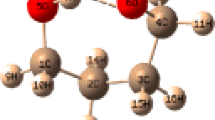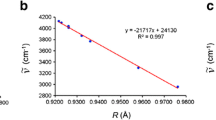Abstract
The present work reports results of computational investigations of hydrogen bonding, with regard to the most common red shift in the vibrational frequency, as well as the less common blue shift in several hydrogen bonded systems. A few new correlations of the frequency shifts with the calculated electrostatic parameters are proposed, thereby generating new insight into both types of the frequency shifts. Thus, the frequency shifts in X—H—-Y hydrogen bonded systems at different H—Y distances are shown to correlate well with the Mulliken charges on H and Y, with the positive and negative charges on Y correlating with the blue and red shift of the frequency of X—H vibration, respectively. The role played by charge transfers at other parts of the interacting system is also discussed.
GRAPHICAL ABSTRACT
Synopsis The blue and red shifts in vibrational frequency in X—H...Y hydrogen bonded systems as a function of H—-Y distance are shown to correlate well with the atomic charges on H and Y as well as other electrostatic parameters.






Similar content being viewed by others
References
Jeffrey G A 1997 In An Introduction to Hydrogen Bonding (New York: Oxford University Press)
Arunan E, Desiraju G R, Klein R A, Sadlej J, Scheiner S, Alkorta I, Clary D C, Crabtree R H, Dannenberg J J, Hobza P, Kjaergaard H G, Legon A C, Mennucci B and Nesbitt D J 2011 Definition of the Hydrogen Bond Pure Appl. Chem. 83 1637
(a) Desiraju G R 2011 A bond by any other name Angew. Chem. Int. Ed. 50 52; (b) Desiraju G R 1991 The C-H...O Hydrogen Bond in Crystals: What is it? Acc. Chem. Res. 24 290
Hobza P and Havlas Z 2000 Blue-Shifting Hydrogen Bonds Chem. Rev. 100 4253
Joseph J and Jemmis E D 2007 Red-, Blue-, or No-Shift in Hydrogen Bonds: A Unified Explanation J. Am. Chem. Soc. 129 4620
Li X, Liu L and Schlegel H B 2002 On the physical origin of blue-shifted hydrogen bonds J. Am. Chem. Soc. 124 9639
Alabugin I V, Monoharan M, Peabody S and Weinhold F 2003 Electronic basis of improper hydrogen bonding: a subtle balance of hyperconjugation and rehybridization J. Am. Chem. Soc. 125 5973
Li A Y 2007 Chemical origin of blue- and redshifted hydrogen bonds: intramolecular hyperconjugation and its coupling with intermolecular hyperconjugation J. Chem. Phys. 126 154102
(a) Hobza P 2001 The H-index unambiguously discriminates between hydrogen bonding and improper blue-shifting hydrogen bonding Chem. Phys. Phys. Chem. 3 2555; (b) Hobza P and Havlas Z 2002 Improper, blue-shifting hydrogen bond Theor. Chem. Acc. 108 325
Hobza P, Špirko V, Havlas Z, Buchhold K, Reimann B, Barth H and Brutschy B 1999 Anti-hydrogen bond between chloroform and fluorobenzene Chem. Phys. Lett. 299 180
Rozenberg M, Loewenschuss A and Marcus Y 2000 An empirical correlation between stretching vibration redshift and hydrogen bond length Phys. Chem. Chem. Phys. 2 2699
Scheiner S and Kar T 2002 Red- versus Blue-Shifting Hydrogen Bonds: Are There Fundamental Distinctions J. Phys. Chem. A 106 1784
Gilli G and Gilli P 2000 Towards an unified hydrogen-bond theory J. Mol. Struct. 552 1
Hermansson K 2002 Blue-Shifting Hydrogen Bonds J. Phys. Chem. A 106 4695
Wang J, Feng Y, Liu L, Li X and Guo Q 2004 On the correlation between the blue shift of hydrogen bonding and the proton donor-proton acceptor distance Chin. J. Chem. 22 642
Lu P, Liu G and Li J 2005 Existing problems in theoretical determination of red-shifted or blue-shifted hydrogen bond J. Mol. Struct. 723 95
Wang S, Sahu P K and Lee S 2005 Intermolecular orbital repulsion effect on the blue-shifted hydrogen bond Chem. Phys. Lett. 406 143
Hoja J, Sax, A F and Szalewicz K 2014 Is Electrostatics Sufficient to Describe Hydrogen-Bonding Interactions? Chem. Eur. J. 20 2292
Senthilkumar L, Ghanty T K, Ghosh S K and Kolandaivel P 2006 Hydrogen bonding in substituted formic acid dimers J. Phys. Chem. 110 12623
Senthilkumar L, Ghanty T K and Ghosh S K 2006 Electron density and energy decomposition analysis in hydrogen-bonded complexes of azabenzenes with water, acetamide, and thioacetamide J. Phys. Chem. A 109 7575
Kolandaivel P and Nirmala V 2004 Study of proper and improper hydrogen bonding using Bader’s atoms in molecules (AIM) theory and NBO analysis J. Mol. Struct. 694 33
Parthasarathy R, Subramanian V and Sathyamurthy N 2006 Hydrogen bonding without borders: An atom in molecules perspective J. Phys. Chem. Lett. 110 3349
Dey A, Mondal S I, Sen S, Ghosh D and Patwari G N 2014 Electrostatics determine vibrational frequency shifts in hydrogen bonded complexes Phys. Chem. Chem. Phys. 16 25247
Dey A, Mondal S I, Sen S and Patwari G N 2016 Spectroscopic and Ab Initio Investigation of \(\text{ C }-\text{ H }\cdots \text{ N }\) Hydrogen-Bonded Complexes of Fluorophenylacetylenes: Frequency Shifts and Correlations ChemPhysChem 17 2509
Shirhatti P R, Maity D K and Wategaonkar S 2013 \(\text{ C }-\text{ H }\cdots \text{ Y }\) hydrogen bonds in the complexes of p-cresol and p-cyanophenol with fluoroform and chloroform J. Phys. Chem. A 117 2307
Banerjee P, Mukhopadhyay D P and Chakraborty T 2015 On the origin of donor O-H bond weakening in phenol-water complexes J. Chem. Phys. 143 204306
Goswami M and Arunan E 2009 The hydrogen bond: a molecular beam microwave spectroscopist’s view with a universal appeal Phys. Chem. Chem. Phys. 11 8974
Saggu M, Levinson N M and Boxer S G 2012 Experimental Quantification of Electrostatics in \(\text{ X }\text{-- }\text{ H }\cdot \cdot \cdot \pi \) Hydrogen Bonds J. Am. Chem. Soc. 134 18986
Schmidt M W, Baldridge K K, Botaz J A, Elbert S T, Gordon M S, Jensen J, Koseki S, Matsunaga N, Nguyen K A, Su S, Windus T L, Dupuis M and Montgomery J A 1993 General atomic and molecular electronic structure system J. Comp. Chem. 14 1347
Gilli P, Bertolasi V, Ferretti V and Gilli G 1994 Covalent Nature of the Strong Homonuclear Hydrogen Bond. Study of the O—H...O System by Crystal Structure Correlation Methods J. Am. Chem. Soc. 116 909
Umeyama H and Morokuma K 1977 The Origin of Hydrogen Bonding. An Energy Decomposition Study J. Am. Chem. Soc. 99 1316
Saha R, Pan S, Frenking G, Chattaraj P K and Merino G 2017 The strongest CO binding and the highest C–O stretching frequency Phys. Chem. Chem. Phys. 19 2286
Acknowledgements
We are thankful to all the three National Science Academies of India for the award of Academy Summer Research Fellowship (2016) and DST, India for the award of INSPIRE fellowship to one of us (MD). SKG thanks DAE, India for the Raja Ramanna Fellowship and UM-DAE-Centre of Excellence for Basic Sciences, Mumbai for a Distinguished Professorship.
Author information
Authors and Affiliations
Corresponding author
Additional information
Dedicated to the memory of the late Professor Charusita Chakravarty.
Electronic supplementary material
Below is the link to the electronic supplementary material.
Rights and permissions
About this article
Cite this article
Das, M., Ghosh, S.K. A computational investigation of the red and blue shifts in hydrogen bonded systems. J Chem Sci 129, 975–981 (2017). https://doi.org/10.1007/s12039-017-1304-4
Received:
Revised:
Accepted:
Published:
Issue Date:
DOI: https://doi.org/10.1007/s12039-017-1304-4




